Unmasking People’s Opinions behind Mask-Wearing during COVID-19 Pandemic—A Twitter Stance Analysis
Abstract
:1. Introduction
2. Literature Review
2.1. Mask Related Works in COVID-19 Context
2.2. Twitter Analysis on COVID-19 Data
3. Methodology
3.1. Dataset Collection Step
3.2. Classifiers Training and Selection Step
- in favor—all the tweets expressing positive messages regarding the use of masks during the COVID-19 pandemic with the purpose of protecting the wearer of the mask or the persons in his/her vicinity;
- neutral—all the tweets referring to news related to mask-wearing, changes in the mask-wearing policies in different parts of the world or indoor/outdoor; information related to the efficiency of different types of masks; announcements related to mask-selling offers; and all the tweets that do not express a clear opinion related to mask-wearing;
- against—all the tweets presenting a negative message regarding mask-wearing, including the refusal of wearing such a mask under all/any circumstances.
3.3. Stance Detection Step
4. COVID-19 Mask Stance Dataset
5. COVID-19 Mask Stance Detection
5.1. Mask Stance Detection on Cleaned Dataset
5.2. Mask Stance Detection on Entire Dataset
5.3. Mask Stance Detection Evolution in Both Cleaned and Entire Datasets
6. Analyzing Mask-Wearing Opinions
6.1. Periods with High Tweet Activity
6.1.1. P1: 4 April 2020
6.1.2. P2: 2 July 2020
6.1.3. P3: 12 July 2020–17 July 2020
6.1.4. P4: 29 July 2020–30 July 2020
6.1.5. P5: 2 October 2020–6 October 2020
6.1.6. P6: 9 November 2020–24 November 2020
6.1.7. P7: 4 December 2020–6 December 2020
6.1.8. P8: 30 December 2020
6.2. Days with Peak Activity on Each Tweet Category
6.2.1. D1: 12 November 2020—Announcement by United States Center for Disease Control
6.2.2. D2: 6 October 2020—Trump Removes Mask after COVID-19 Treatment
6.2.3. D3: 18 November 2020—Danish Study Finds Mask Wearing Inefficient
7. Discussions and Limitations of the Study
8. Conclusions
Supplementary Materials
Author Contributions
Funding
Institutional Review Board Statement
Informed Consent Statement
Data Availability Statement
Conflicts of Interest
Appendix A
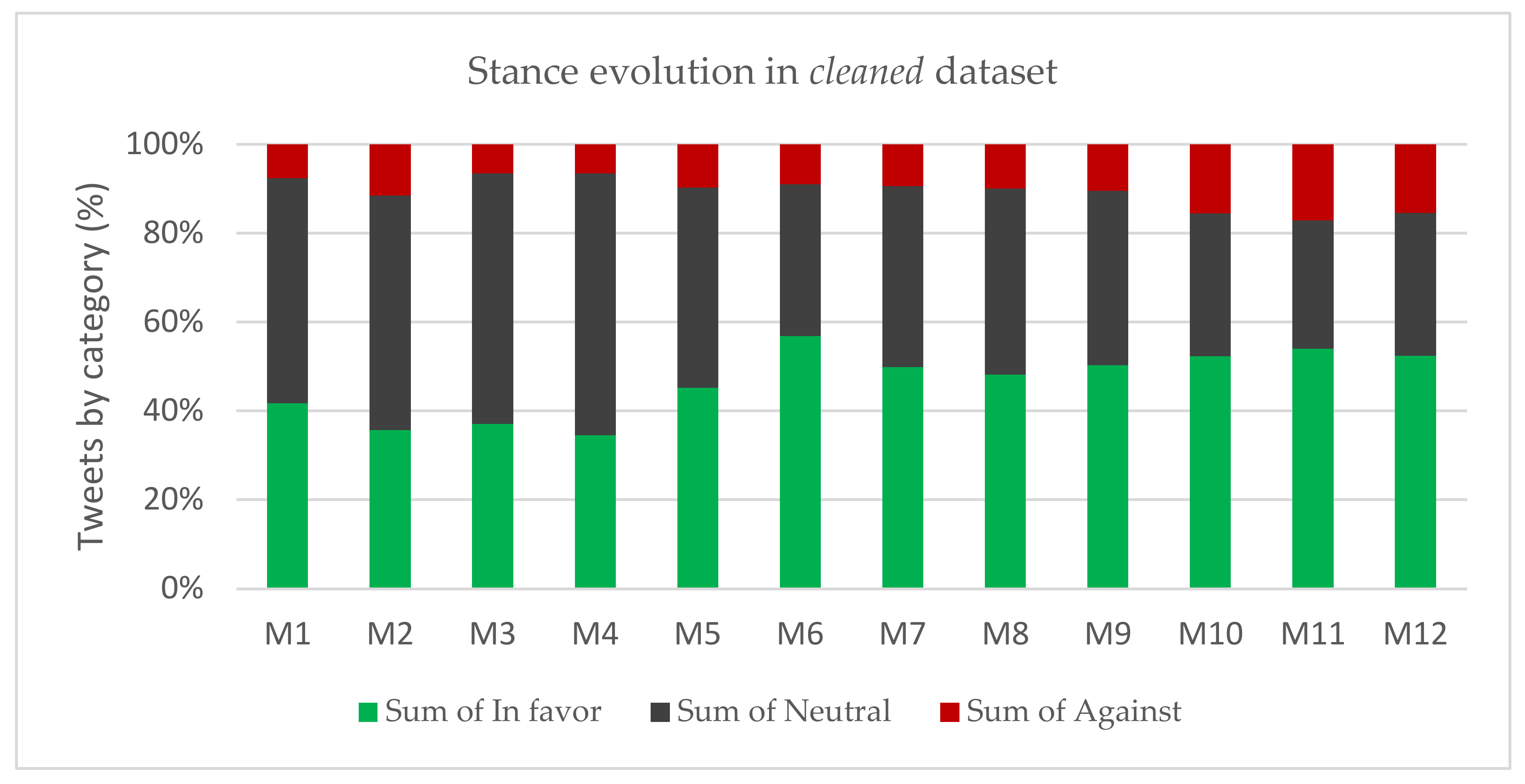
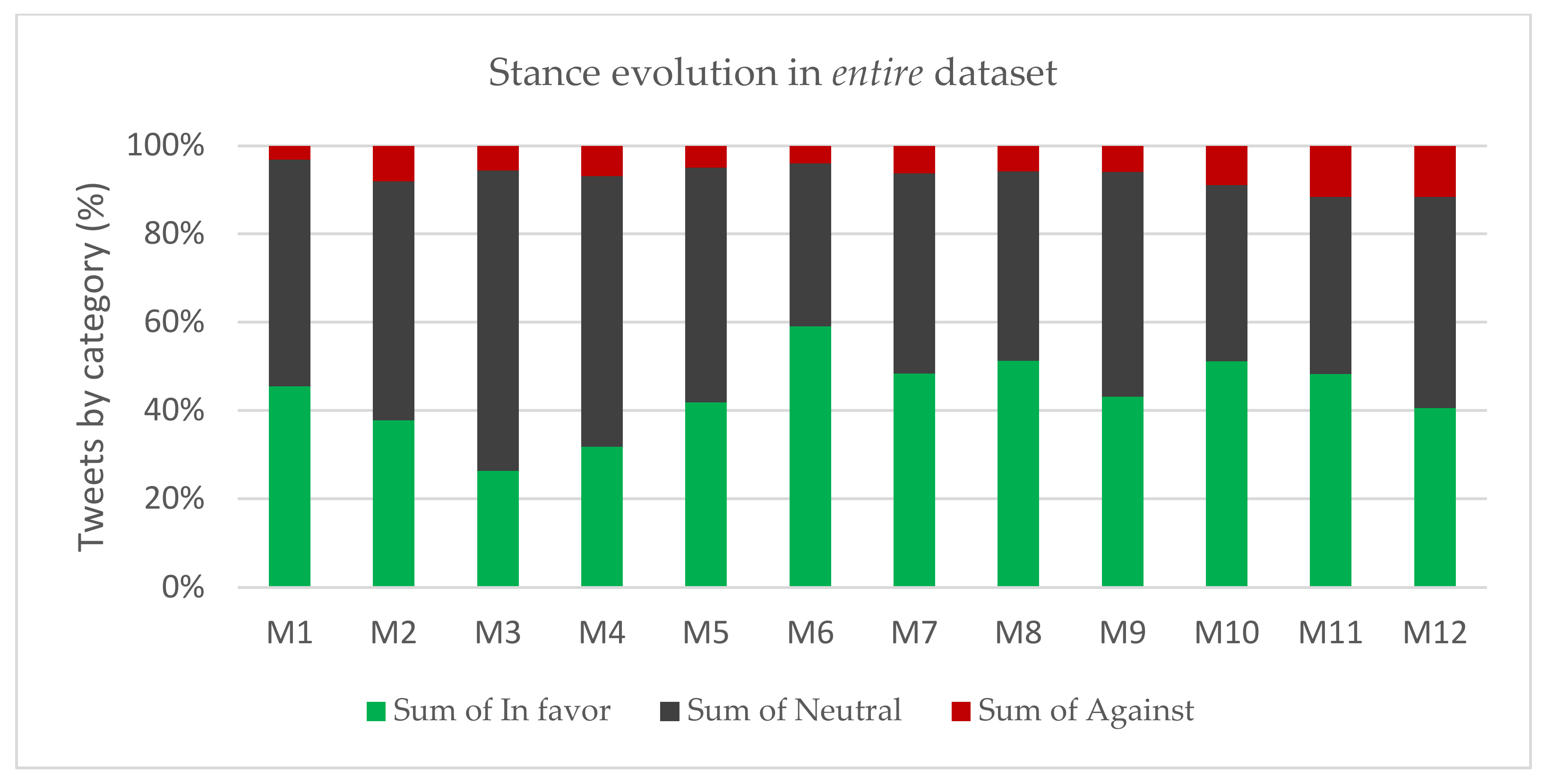
References
- Ozili, P.K.; Arun, T. Spillover of COVID-19: Impact on the Global Economy. SSRN Electron. J. 2020. [Google Scholar] [CrossRef] [Green Version]
- Milne, R.J.; Delcea, C.; Cotfas, L.-A. Airplane boarding methods that reduce risk from COVID-19. Saf. Sci. 2020, 134, 105061. [Google Scholar] [CrossRef]
- Hale, T.; Angrist, N.; Goldszmidt, R.; Kira, B.; Petherick, A.; Phillips, T.; Webster, S.; Cameron-Blake, E.; Hallas, L.; Majumdar, S.; et al. A global panel database of pandemic policies (Oxford COVID-19 Government Response Tracker). Nat. Hum. Behav. 2021, 5, 529–538. [Google Scholar] [CrossRef]
- World Health Organization. Advice on the Use of Masks in the Community, during Home Care and in Healthcare Settings in the Context of the Novel Coronavirus (COVID-19) Outbreak. Available online: https://www.who.int/publications/i/item/advice-on-the-use-of-masks-in-the-community-during-home-care-and-in-healthcare-settings-in-the-context-of-the-novel-coronavirus-(2019-ncov)-outbreak (accessed on 2 March 2021).
- Leffler, C.T.; Ing, E.; Lykins, J.D.; Hogan, M.C.; McKeown, C.A.; Grzybowski, A. Association of Country-wide Coronavirus Mortality with Demographics, Testing, Lockdowns, and Public Wearing of Masks. Am. J. Trop. Med. Hyg. 2020, 103, 2400–2411. [Google Scholar] [CrossRef]
- Ma, Y.; Zhan, N. To mask or not to mask amid the COVID-19 pandemic: How Chinese students in America experience and cope with stigma. Chin. Sociol. Rev. 2020, 1–26. [Google Scholar] [CrossRef]
- Mw, Z.M.W. Mask crisis during the COVID-19 outbreak. Eur. Rev. Med. Pharmacol. Sci. 2020, 24, 3397–3399. [Google Scholar] [CrossRef]
- Grundmann, F.; Epstude, K.; Scheibe, S. Face Masks Reduce Emotion-Recognition Accuracy and Perceived Closeness. PLoS ONE 2021, 16, e0249792. [Google Scholar] [CrossRef] [PubMed]
- Scheid, J.L.; Lupien, S.P.; Ford, G.S.; West, S.L. Commentary: Physiological and Psychological Impact of Face Mask Usage during the COVID-19 Pandemic. Int. J. Environ. Res. Public Health 2020, 17, 6655. [Google Scholar] [CrossRef]
- Rieger, M.O. To wear or not to wear? Factors influencing wearing face masks in Germany during the COVID-19 pandemic. Soc. Health Behav. 2020, 3, 50. [Google Scholar] [CrossRef]
- Vahedian-Azimi, A.; Makvandi, S.; Karimi, L. Cultural Reasons: The Most Important Factors in Resisting Wearing a Mask. Hosp. Pract. Res. 2020, 5, 120–121. [Google Scholar] [CrossRef]
- Selvaranjan, K.; Navaratnam, S.; Rajeev, P.; Ravintherakumaran, N. Environmental challenges induced by extensive use of face masks during COVID-19: A review and potential solutions. Environ. Chall. 2021, 3, 100039. [Google Scholar] [CrossRef]
- Alamoodi, A.; Zaidan, B.; Zaidan, A.; Albahri, O.; Mohammed, K.; Malik, R.; Almahdi, E.; Chyad, M.; Tareq, Z.; Hameed, H.; et al. Sentiment analysis and its applications in fighting COVID-19 and infectious diseases: A systematic review. Expert Syst. Appl. 2020, 167, 114155. [Google Scholar] [CrossRef]
- Cotfas, L.-A.; Delcea, C.; Roxin, I.; Ioanas, C.; Gherai, D.S.; Tajariol, F. The Longest Month: Analyzing COVID-19 Vaccination Opinions Dynamics from Tweets in the Month Following the First Vaccine Announcement. IEEE Access 2021, 9, 33203–33223. [Google Scholar] [CrossRef]
- Cotfas, L.-A.; Delcea, C.; Gherai, R. COVID-19 Vaccine Hesitancy in the Month Following the Start of the Vaccination Process. Int. J. Environ. Res. Public Health 2021, 18, 10438. [Google Scholar] [CrossRef]
- Chakraborty, K.; Bhatia, S.; Bhattacharyya, S.; Platos, J.; Bag, R.; Hassanien, A.E. Sentiment Analysis of COVID-19 tweets by Deep Learning Classifiers—A study to show how popularity is affecting accuracy in social media. Appl. Soft Comput. 2020, 97, 106754. [Google Scholar] [CrossRef]
- Sun, C.X.; He, B.; Mu, D.; Li, P.L.; Zhao, H.T.; Li, Z.L.; Zhang, M.L.; Feng, L.Z.; Zheng, J.D.; Cheng, Y.; et al. Public Awareness and Mask Usage during the COVID-19 Epidemic: A Survey by China CDC New Media. Biomed. Environ. Sci. 2020, 33, 639–645. [Google Scholar] [PubMed]
- Goldberg, M.H.; Gustafson, A.; Maibach, E.; Ballew, M.T.; Bergquist, P.; Kotcher, J.; Marlon, J.R.; Rosenthal, S.A.; Leiserowitz, A. Mask-Wearing Increased After a Government Recommendation: A Natural Experiment in the U.S. during the COVID-19 Pandemic. Front. Commun. 2020, 5. [Google Scholar] [CrossRef]
- Hao, F.; Shao, W.; Huang, W. Understanding the influence of contextual factors and individual social capital on American public mask wearing in response to COVID–19. Health Place 2021, 68, 102537. [Google Scholar] [CrossRef] [PubMed]
- Stosic, M.D.; Helwig, S.; Ruben, M.A. Greater belief in science predicts mask-wearing behavior during COVID-19. Pers. Individ. Differ. 2021, 176, 110769. [Google Scholar] [CrossRef] [PubMed]
- Van Dyke, M.E.; Rogers, T.M.; Pevzner, E.; Satterwhite, C.L.; Shah, H.B.; Beckman, W.J.; Ahmed, F.; Hunt, D.C.; Rule, J. Trends in County-Level COVID-19 Incidence in Counties with and Without a Mask Mandate—Kansas, June 1–August 23, 2020. MMWR. Morb. Mortal. Wkly. Rep. 2020, 69, 1777–1781. [Google Scholar] [CrossRef]
- Krishnamachari, B.; Morris, A.; Zastrow, D.; Dsida, A.; Harper, B.; Santella, A.J. The role of mask mandates, stay at home orders and school closure in curbing the COVID-19 pandemic prior to vaccination. Am. J. Infect. Control 2021, 49, 1036–1042. [Google Scholar] [CrossRef]
- Gondim, J.A. Preventing epidemics by wearing masks: An application to COVID-19. Chaos Solitons Fractals 2020, 143, 110599. [Google Scholar] [CrossRef]
- Raymond, J. The Great Mask Debate: A Debate That Shouldn’t Be a Debate at All. WMJ 2020, 119, 229–239. [Google Scholar]
- Abboah-Offei, M.; Salifu, Y.; Adewale, B.; Bayuo, J.; Ofosu-Poku, R.; Opare-Lokko, E.B.A. A rapid review of the use of face mask in preventing the spread of COVID-19. Int. J. Nurs. Stud. Adv. 2020, 3, 100013. [Google Scholar] [CrossRef] [PubMed]
- Li, Y.; Liang, M.; Gao, L.; Ahmed, M.A.; Uy, J.P.; Cheng, C.; Zhou, Q.; Sun, C. Face masks to prevent transmission of COVID-19: A systematic review and meta-analysis. Am. J. Infect. Control 2020, 49, 900–906. [Google Scholar] [CrossRef] [PubMed]
- Boccardo, L. Self-reported symptoms of mask-associated dry eye: A survey study of 3,605 people. Contact Lens Anterior Eye 2021, 101408. [Google Scholar] [CrossRef] [PubMed]
- Silkiss, R.Z.; Paap, M.K.; Ugradar, S. Increased incidence of chalazion associated with face mask wear during the COVID-19 pandemic. Am. J. Ophthalmol. Case Rep. 2021, 22, 101032. [Google Scholar] [CrossRef] [PubMed]
- Maura, I.D.Y.I.; Genís, J.T.; Zabala, D.D.; Monaco, M.; Garcia, J.S.; Vielba, F.R.; i Turcó, J.V.; Grazioli, G. COVID-19: Analysis of cavitary air inspired through a mask, in competitive adolescent athletes. Apunt. Sports Med. 2021, 56, 100349. [Google Scholar] [CrossRef]
- Dost, B.; Kömürcü, Ö.; Bilgin, S.; Dokmeci, H.; Terzi, Ö.; Baris, S. Investigating the Effects of Protective Face Masks on the Respiratory Parameters of Children in the Post-Anesthesia Care Unit During the COVID-19 Pandemic. J. PeriAnesthesia Nurs. 2021. [Google Scholar] [CrossRef]
- Mueller, A.S.; Diefendorf, S.; Abrutyn, S.; Beardall, K.A.; Millar, K.; O’Reilly, L.; Steinberg, H.; Watkins, J.T. Youth Mask-Wearing and Social-Distancing Behavior at In-Person High School Graduations During the COVID-19 Pandemic. J. Adolesc. Health 2021, 68, 464–471. [Google Scholar] [CrossRef]
- Hantoko, D.; Li, X.; Pariatamby, A.; Yoshikawa, K.; Horttanainen, M.; Yan, M. Challenges and practices on waste management and disposal during COVID-19 pandemic. J. Environ. Manag. 2021, 286, 112140. [Google Scholar] [CrossRef]
- Dharmaraj, S.; Ashokkumar, V.; Hariharan, S.; Manibharathi, A.; Show, P.L.; Chong, C.T.; Ngamcharussrivichai, C. The COVID-19 pandemic face mask waste: A blooming threat to the marine environment. Chemosphere 2021, 272, 129601. [Google Scholar] [CrossRef]
- Fadare, O.O.; Okoffo, E.D. Covid-19 face masks: A potential source of microplastic fibers in the environment. Sci. Total. Environ. 2020, 737, 140279. [Google Scholar] [CrossRef]
- Hartanto, B.W.; Mayasari, D.S. Environmentally friendly non-medical mask: An attempt to reduce the environmental impact from used masks during COVID 19 pandemic. Sci. Total. Environ. 2020, 760, 144143. [Google Scholar] [CrossRef]
- Xiang, Y.; Song, Q.; Gu, W. Decontamination of surgical face masks and N95 respirators by dry heat pasteurization for one hour at 70 °C. Am. J. Infect. Control. 2020, 48, 880–882. [Google Scholar] [CrossRef] [PubMed]
- Rubio-Romero, J.C.; Pardo-Ferreira, M.D.C.; Torrecilla-García, J.A.; Calero-Castro, S. Disposable masks: Disinfection and sterilization for reuse, and non-certified manufacturing, in the face of shortages during the COVID-19 pandemic. Saf. Sci. 2020, 129, 104830. [Google Scholar] [CrossRef] [PubMed]
- Chu, D.; Akl, E.A.; Duda, S.; Solo, K.; Yaacoub, S.; Schünemann, H.J.; El-Harakeh, A.; Bognanni, A.; Lotfi, T.; Loeb, M.; et al. Physical distancing, face masks, and eye protection to prevent person-to-person transmission of SARS-CoV-2 and COVID-19: A systematic review and meta-analysis. Lancet 2020, 395, 1973–1987. [Google Scholar] [CrossRef]
- Howard, J.; Huang, A.; Li, Z.; Tufekci, Z.; Zdimal, V.; van der Westhuizen, H.-M.; von Delft, A.; Price, A.; Fridman, L.; Tang, L.-H.; et al. An evidence review of face masks against COVID-19. Proc. Natl. Acad. Sci. USA 2021, 118. [Google Scholar] [CrossRef] [PubMed]
- Liao, M.; Liu, H.; Wang, X.; Hu, X.; Huang, Y.; Liu, X.; Brenan, K.; Mecha, J.; Nirmalan, M.; Lu, J.R. A technical review of face mask wearing in preventing respiratory COVID-19 transmission. Curr. Opin. Colloid Interface Sci. 2021, 52, 101417. [Google Scholar] [CrossRef]
- Haman, M. The use of Twitter by state leaders and its impact on the public during the COVID-19 pandemic. Heliyon 2020, 6, e05540. [Google Scholar] [CrossRef] [PubMed]
- Koh, J.X.; Liew, T.M. How loneliness is talked about in social media during COVID-19 pandemic: Text mining of 4492 Twitter feeds. J. Psychiatr. Res. 2020. [Google Scholar] [CrossRef]
- Singh, P.; Singh, S.; Sohal, M.; Dwivedi, Y.K.; Kahlon, K.S.; Sawhney, R.S. Psychological fear and anxiety caused by COVID-19: Insights from Twitter analytics. Asian J. Psychiatry 2020, 54, 102280. [Google Scholar] [CrossRef]
- Garcia, K.; Berton, L. Topic detection and sentiment analysis in Twitter content related to COVID-19 from Brazil and the USA. Appl. Soft Comput. 2020, 101, 107057. [Google Scholar] [CrossRef]
- Abd-Alrazaq, A.; Alhuwail, D.; Househ, M.; Hamdi, M.; Shah, Z. Top Concerns of Tweeters during the COVID-19 Pandemic: Infoveillance Study. J. Med. Internet Res. 2020, 22, e19016. [Google Scholar] [CrossRef] [PubMed] [Green Version]
- Kwon, J.; Grady, C.; Feliciano, J.T.; Fodeh, S.J. Defining facets of social distancing during the COVID-19 pandemic: Twitter analysis. J. Biomed. Inform. 2020, 111, 103601. [Google Scholar] [CrossRef]
- Mutlu, E.C.; Oghaz, T.; Jasser, J.; Tutunculer, E.; Rajabi, A.; Tayebi, A.; Ozmen, O.; Garibay, I. A stance data set on polarized conversations on Twitter about the efficacy of hydroxychloroquine as a treatment for COVID-19. Data Brief 2020, 33, 106401. [Google Scholar] [CrossRef] [PubMed]
- Thelwall, M.; Kousha, K.; Thelwall, S. Covid-19 vaccine hesitancy on English-language Twitter. Prof. Inf. 2021, 30. [Google Scholar] [CrossRef]
- Wang, Y.; Hao, H.; Platt, L.S. Examining risk and crisis communications of government agencies and stakeholders during early-stages of COVID-19 on Twitter. Comput. Hum. Behav. 2020, 114, 106568. [Google Scholar] [CrossRef] [PubMed]
- Rao, H.R.; Vemprala, N.; Akello, P.; Valecha, R. Retweets of officials’ alarming vs reassuring messages during the COVID-19 pandemic: Implications for crisis management. Int. J. Inf. Manag. 2020, 55, 102187. [Google Scholar] [CrossRef]
- Morshed, S.A.; Khan, S.S.; Tanvir, R.B.; Nur, S. Impact of COVID-19 pandemic on ride-hailing services based on large-scale Twitter data analysis. J. Urban Manag. 2021, 10, 155–165. [Google Scholar] [CrossRef]
- Rahman, M.; Ali, G.N.; Li, X.J.; Samuel, J.; Paul, K.C.; Chong, P.H.; Yakubov, M. Socioeconomic factors analysis for COVID-19 US reopening sentiment with Twitter and census data. Heliyon 2021, 7, e06200. [Google Scholar] [CrossRef]
- Monmousseau, P.; Marzuoli, A.; Feron, E.; Delahaye, D. Impact of Covid-19 on passengers and airlines from passenger measurements: Managing customer satisfaction while putting the US Air Transportation System to sleep. Transp. Res. Interdiscip. Perspect. 2020, 7, 100179. [Google Scholar] [CrossRef]
- Sarker, A.; Lakamana, S.; Hogg-Bremer, W.; Xie, A.; Al-Garadi, M.A.; Yang, Y.-C. Self-reported COVID-19 symptoms on Twitter: An analysis and a research resource. J. Am. Med. Inform. Assoc. 2020, 27, 1310–1315. [Google Scholar] [CrossRef]
- Huang, X.; Li, Z.; Jiang, Y.; Li, X.; Porter, D. Twitter reveals human mobility dynamics during the COVID-19 pandemic. PLoS ONE 2020, 15, e0241957. [Google Scholar] [CrossRef]
- Al-Rakhami, M.S.; Al-Amri, A.M. Lies Kill, Facts Save: Detecting COVID-19 Misinformation in Twitter. IEEE Access 2020, 8, 155961–155970. [Google Scholar] [CrossRef]
- Shahi, G.K.; Dirkson, A.; Majchrzak, T.A. An exploratory study of COVID-19 misinformation on Twitter. Online Soc. Netw. Media 2021, 22, 100104. [Google Scholar] [CrossRef]
- Abdelminaam, D.S.; Ismail, F.H.; Taha, M.; Taha, A.; Houssein, E.H.; Nabil, A. CoAID-DEEP: An Optimized Intelligent Framework for Automated Detecting COVID-19 Misleading Information on Twitter. IEEE Access 2021, 9, 27840–27867. [Google Scholar] [CrossRef]
- Stephens, M. A geospatial infodemic: Mapping Twitter conspiracy theories of COVID-19. Dialogues Hum. Geogr. 2020, 10, 276–281. [Google Scholar] [CrossRef]
- Banda, J.; Tekumalla, R.; Wang, G.; Yu, J.; Liu, T.; Ding, Y.; Artemova, E.; Tutubalina, E.; Chowell, G. A Large-Scale COVID-19 Twitter Chatter Dataset for Open Scientific Research—An International Collaboration. Epidemiologia 2021, 2, 24. [Google Scholar] [CrossRef]
- D’Andrea, E.; Ducange, P.; Bechini, A.; Renda, A.; Marcelloni, F. Monitoring the public opinion about the vaccination topic from tweets analysis. Expert Syst. Appl. 2018, 116, 209–226. [Google Scholar] [CrossRef]
- Aloufi, S.; El Saddik, A. Sentiment Identification in Football-Specific Tweets. IEEE Access 2018, 6, 78609–78621. [Google Scholar] [CrossRef]
- Baziotis, C.; Pelekis, N.; Doulkeridis, C. DataStories at SemEval-2017 Task 4: Deep LSTM with Attention for Message-Level and Topic-Based Sentiment Analysis. In Proceedings of the 11th International Workshop on Semantic Evaluation (SemEval-2017), Vancouver, BC, Canada, 3–4 August 2017; pp. 747–754. [Google Scholar]
- Bird, S.; Klein, E.; Loper, E. Natural Language Processing with Python: Analyzing Text with the Natural Language Toolkit, 1st ed.; O’Reilly Media: Beijing, China, 2009; ISBN 978-0-596-51649-9. [Google Scholar]
- Zhang, M.-L.; Peña, J.M.; Robles, V. Feature selection for multi-label naive Bayes classification. Inf. Sci. 2009, 179, 3218–3229. [Google Scholar] [CrossRef]
- McCallum, A.; Nigam, K. A Comparison of Event Models for Naive Bayes Text Classification. In AAAI-98 Workshop on Learning for Text Categorization; CiteSeerX: State College, PA, USA, 1998; Volume 752, pp. 41–48. Available online: https://citeseerx.ist.psu.edu/viewdoc/summary?doi=10.1.1.46.1529 (accessed on 11 April 2021).
- Breiman, L. Random Forests. Mach. Learn. 2001, 45, 5–32. [Google Scholar] [CrossRef] [Green Version]
- Misra, S.; Li, H. Noninvasive fracture characterization based on the classification of sonic wave travel times. In Machine Learning for Subsurface Characterization; Gulf Professional Publishing: Houston, TX, USA, 2019; pp. 243–287. [Google Scholar] [CrossRef]
- Platt, J.C. Fast training of support vector machines using sequential minimal optimization. In Advances in Kernel Methods: Support Vector Learning; MIT Press: Cambridge, MA, USA, 1999; pp. 185–208. ISBN 978-0-262-19416-7. [Google Scholar]
- Mohammadi, V.; Minaei, S. Artificial Intelligence in the Production Process. In Engineering Tools in the Beverage Industry; Grumezescu, A.M., Holban, A.M., Eds.; The Science of Beverages; Woodhead Publishing: Sawton, UK, 2019; pp. 27–63. ISBN 978-0-12-815258-4. [Google Scholar]
- Devlin, J.; Chang, M.-W.; Lee, K.; Toutanova, K. BERT: Pre-Training of Deep Bidirectional Transformers for Language Understanding. In Proceedings of the 2019 Conference of the North American Chapter of the Association for Computational Linguistics: Human Language Technologies, Volume 1 (Long and Short Papers), Minneapolis, MN, USA, 2–7 June 2019; pp. 4171–4186. [Google Scholar]
- Liu, Y.; Ott, M.; Goyal, N.; Du, J.; Joshi, M.; Chen, D.; Levy, O.; Lewis, M.; Zettlemoyer, L.; Stoyanov, V. RoBERTa: A Robustly Optimized BERT Pretraining Approach. arXiv 2019, arXiv:1907.11692. [Google Scholar]
- Pedregosa, F.; Varoquaux, G.; Gramfort, A.; Michel, V.; Thirion, B.; Grisel, O.; Blondel, M.; Prettenhofer, P.; Weiss, R.; Dubourg, V.; et al. Scikit-Learn: Machine Learning in Python. J. Mach. Learn. Res. 2011, 12, 2825–2830. [Google Scholar]
- Kibriya, A.M.; Frank, E.; Pfahringer, B.; Holmes, G. Multinomial naive Bayes for text categorization revisited. In Ai 2004: Advances in Artificial Intelligence; Springer: Berlin/Heidelberg, Germany, 2004; Volume 3339, pp. 488–499. ISBN 978-3-540-24059-4. [Google Scholar]
- Hastie, T.; Tibshirani, R.; Friedman, J. The Elements of Statistical Learning: Data Mining, Inference, and Prediction, 2nd ed.; Springer Series in Statistics; Springer: New York, NY, USA, 2009; ISBN 9780387848570. [Google Scholar]
- Tavoschi, L.; Quattrone, F.; D’Andrea, E.; Ducange, P.; Vabanesi, M.; Marcelloni, F.; Lopalco, P.L. Twitter as a sentinel tool to monitor public opinion on vaccination: An opinion mining analysis from September 2016 to August 2017 in Italy. Hum. Vaccines Immunother. 2020, 16, 1062–1069. [Google Scholar] [CrossRef]
- Ahmed, W.; Vidal-Alaball, J.; Segui, F.L.; Moreno-Sánchez, P. A Social Network Analysis of Tweets Related to Masks during the COVID-19 Pandemic. Int. J. Environ. Res. Public Health 2020, 17, 8235. [Google Scholar] [CrossRef]
- Keller, S.; Honea, J.; Ollivant, R. How Social Media Comments Inform the Promotion of Mask-Wearing and Other COVID-19 Prevention Strategies. Int. J. Environ. Res. Public Health. 2021, 18, 5624. [Google Scholar] [CrossRef]
- Giachanou, A.; Crestani, F. Like It or Not: A Survey of Twitter Sentiment Analysis Methods. ACM Comput. Surv. 2016, 49, 1–41. [Google Scholar] [CrossRef]

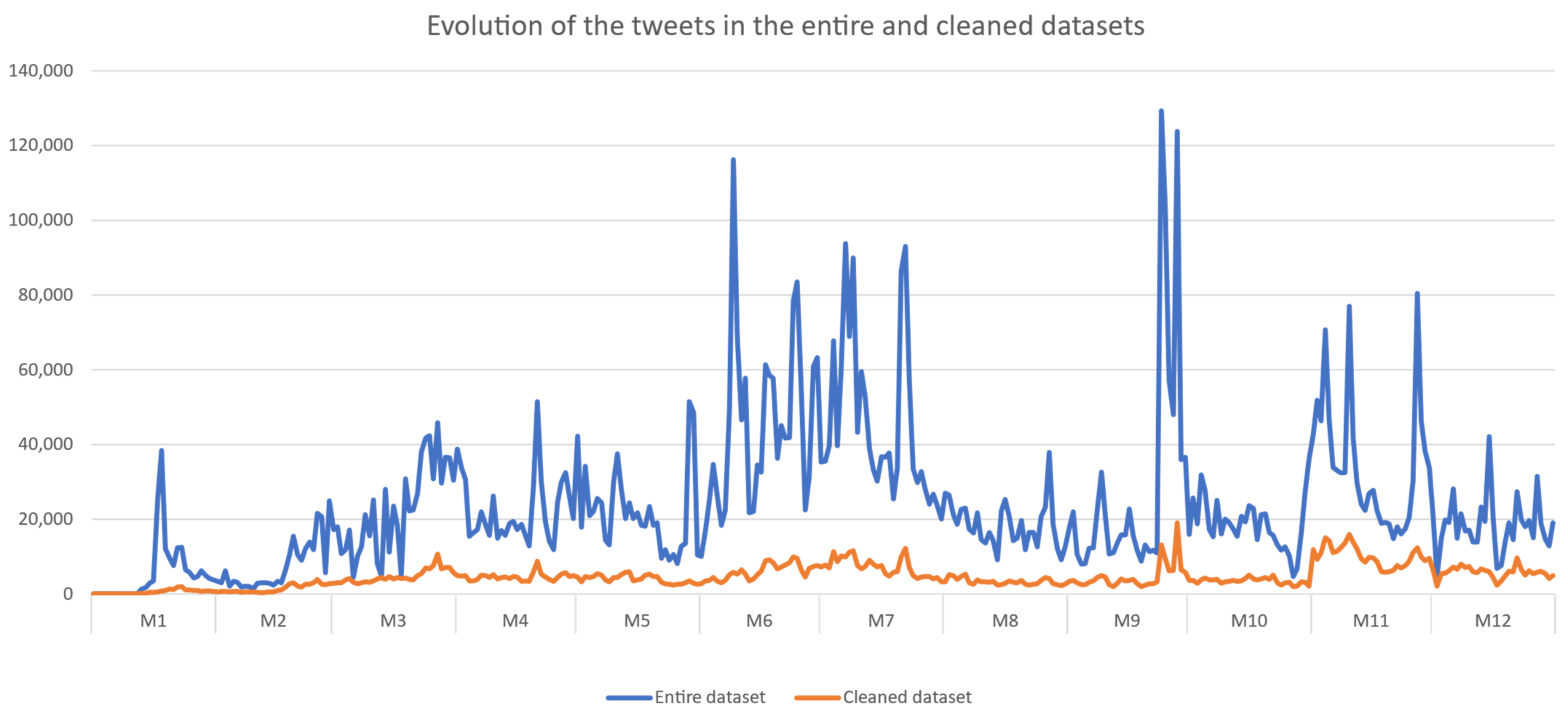
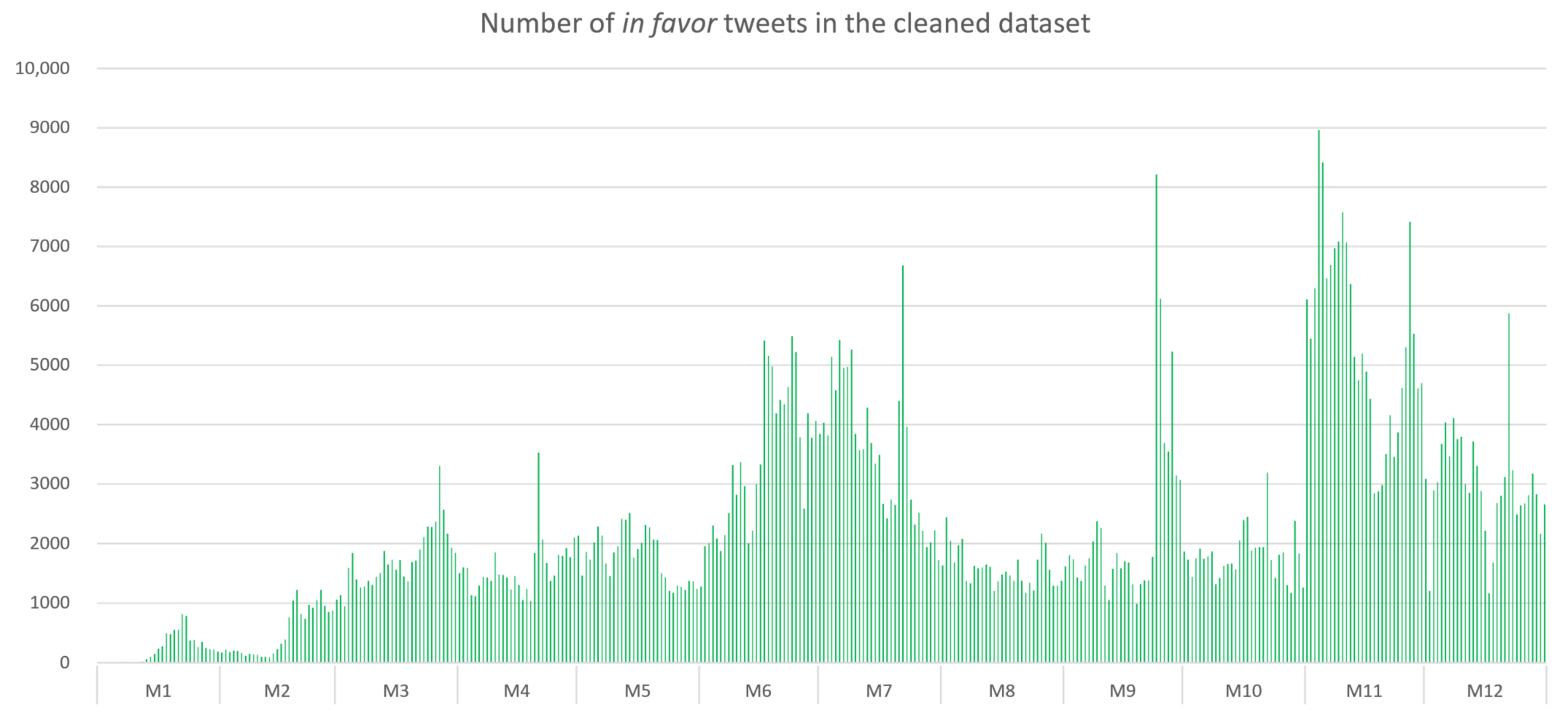
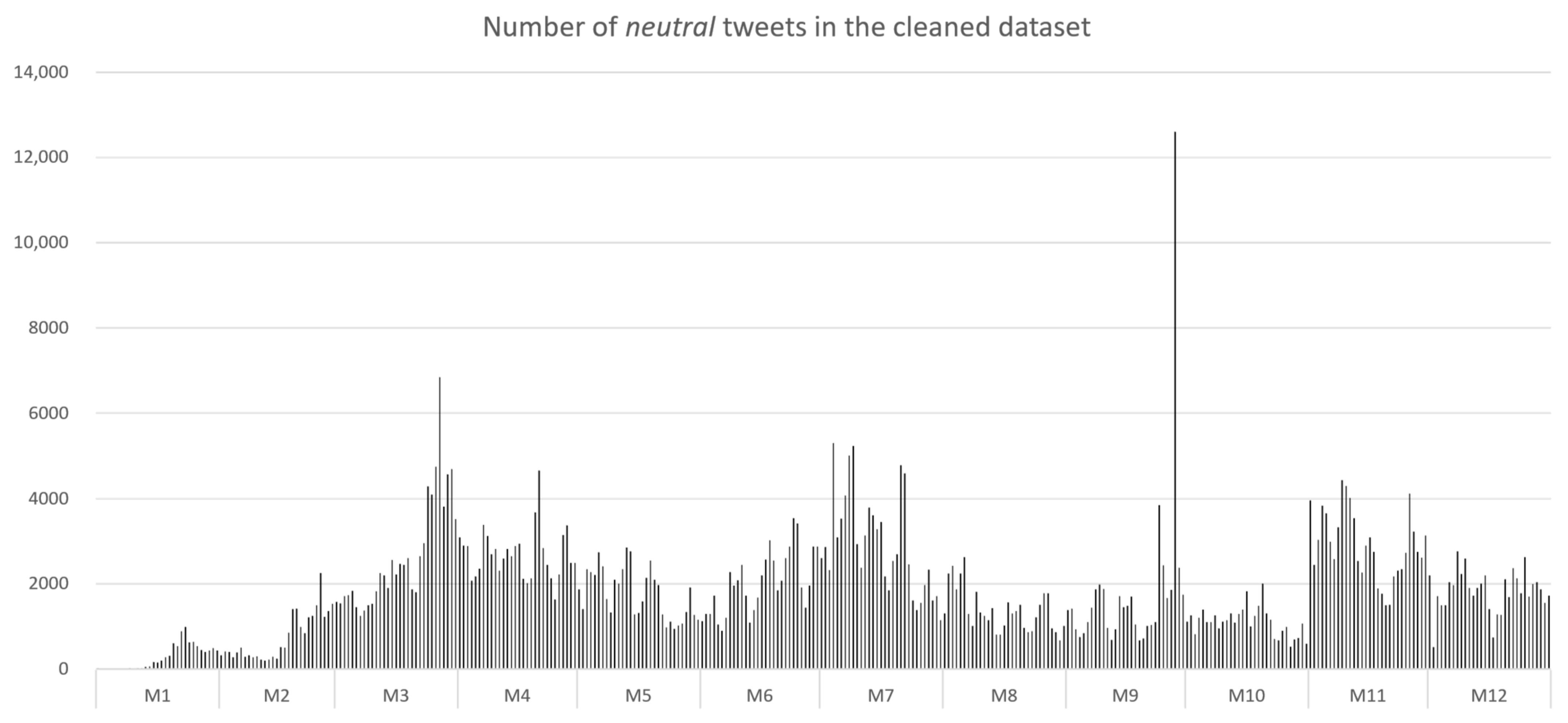
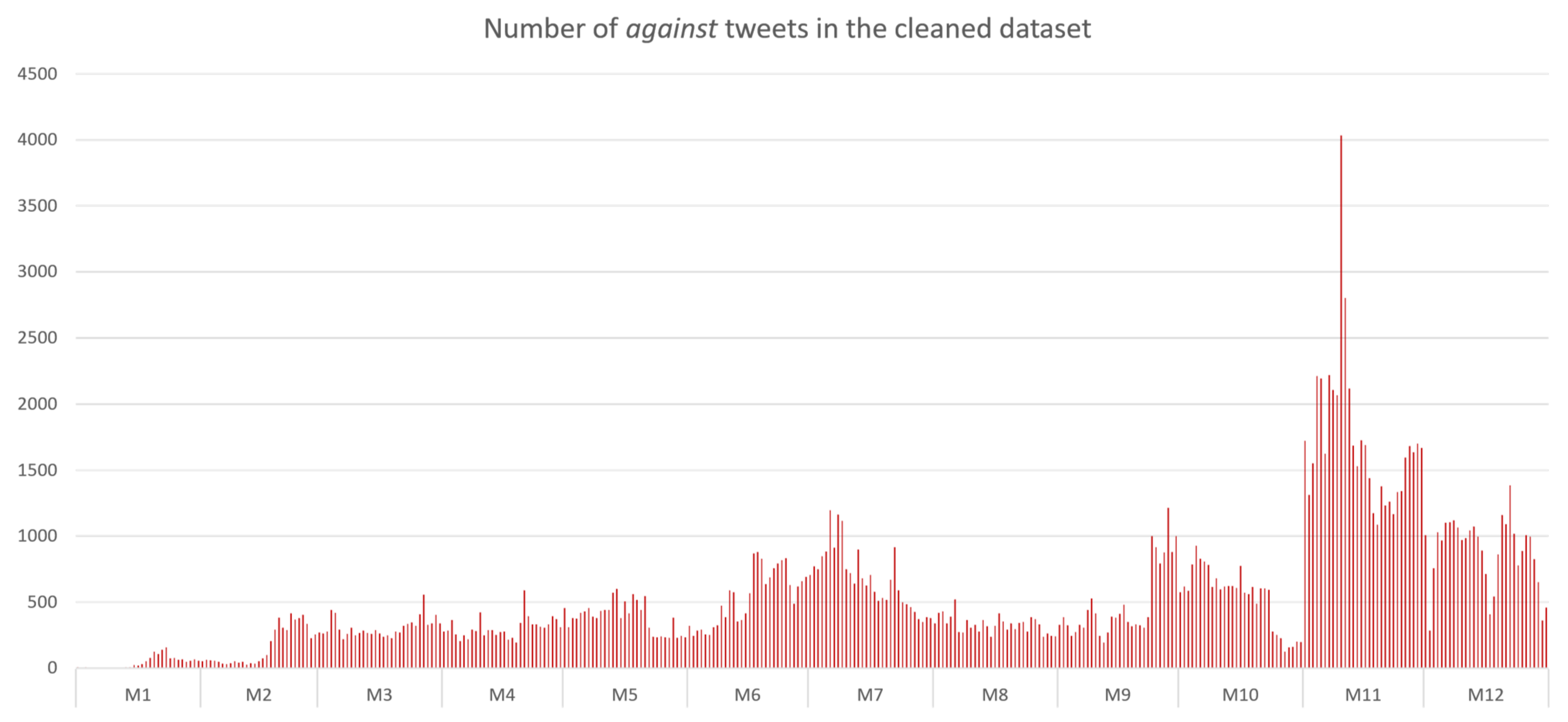

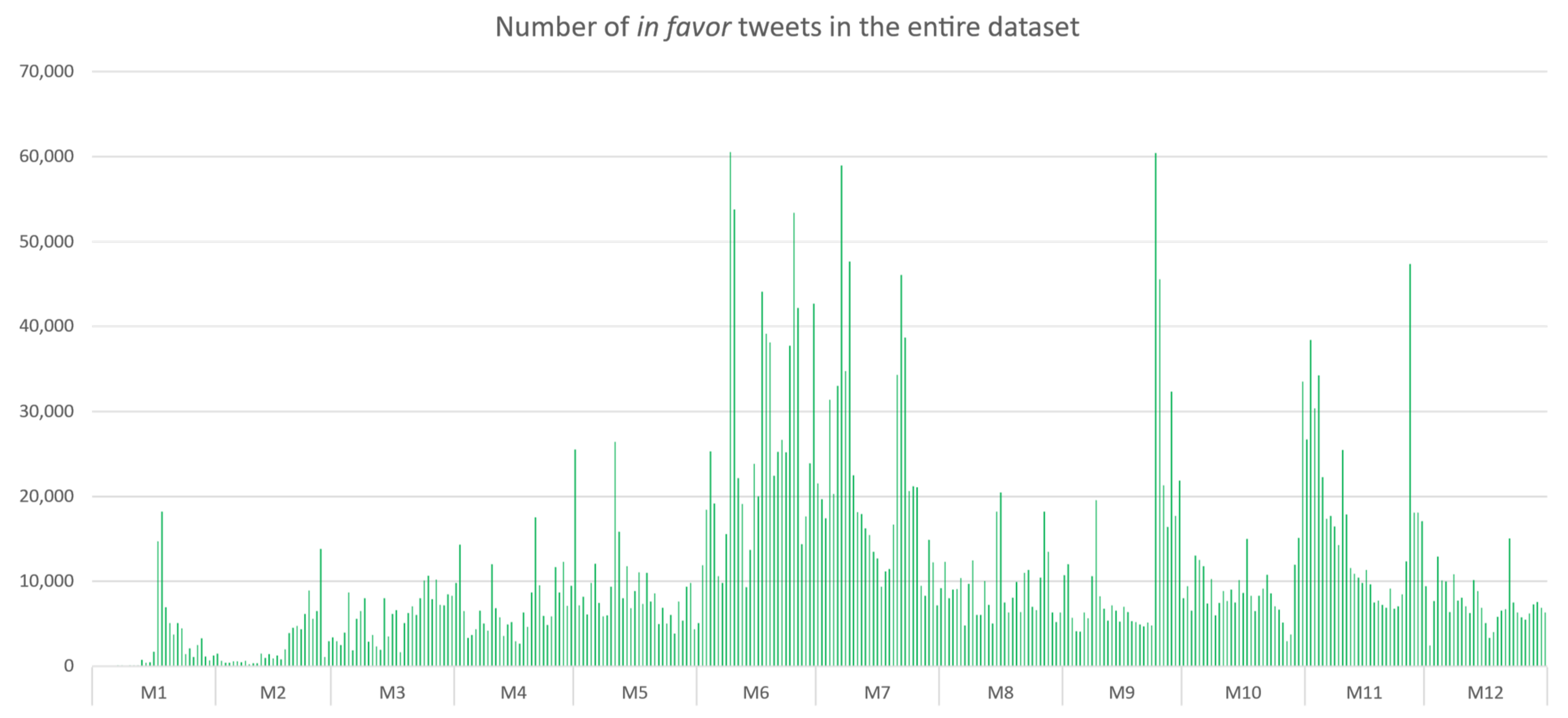
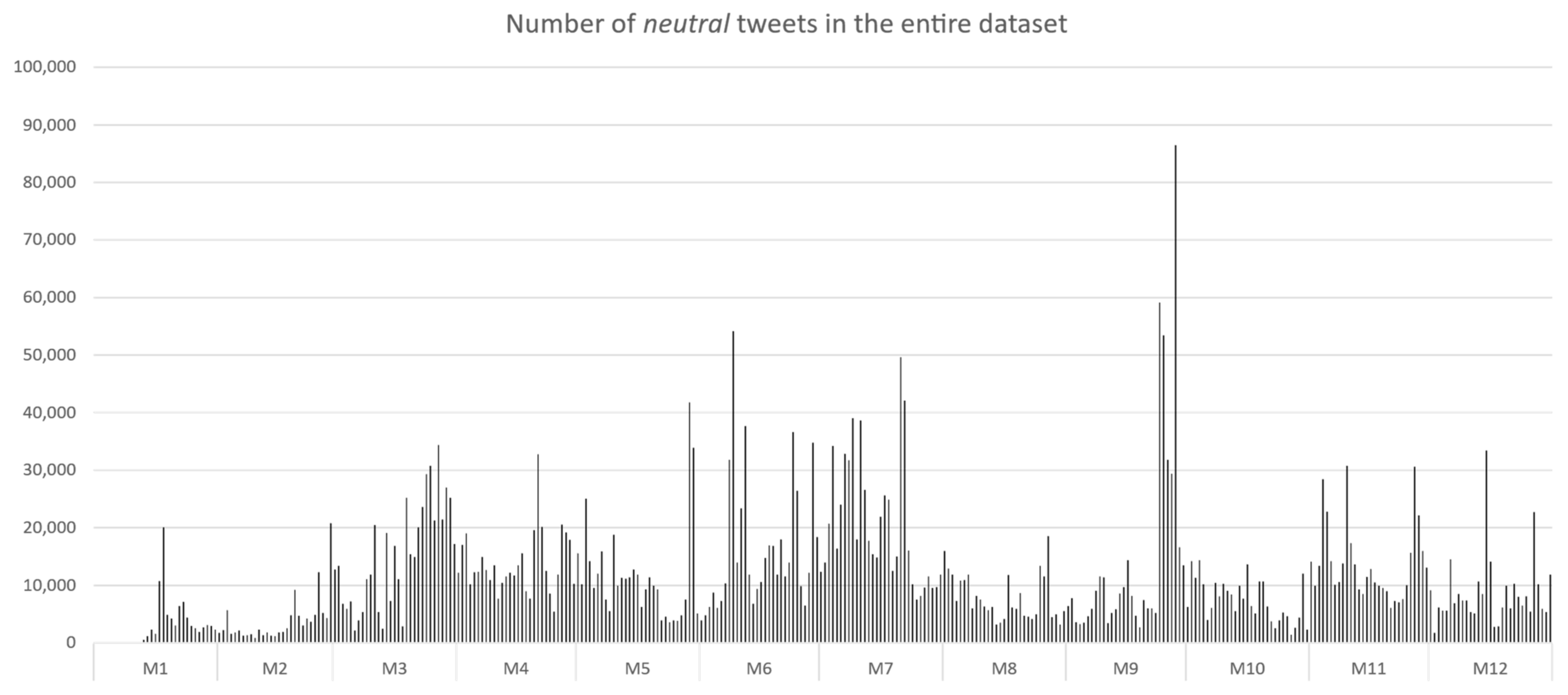
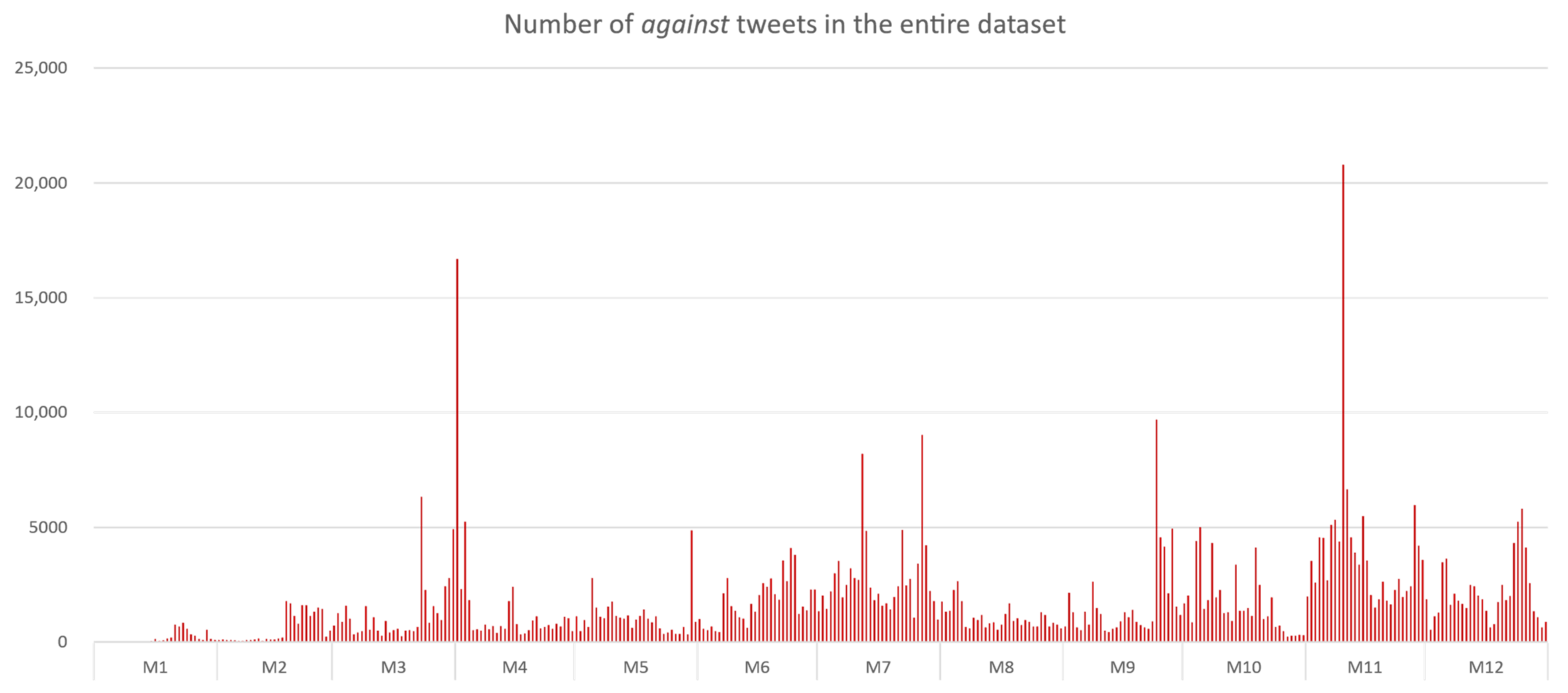
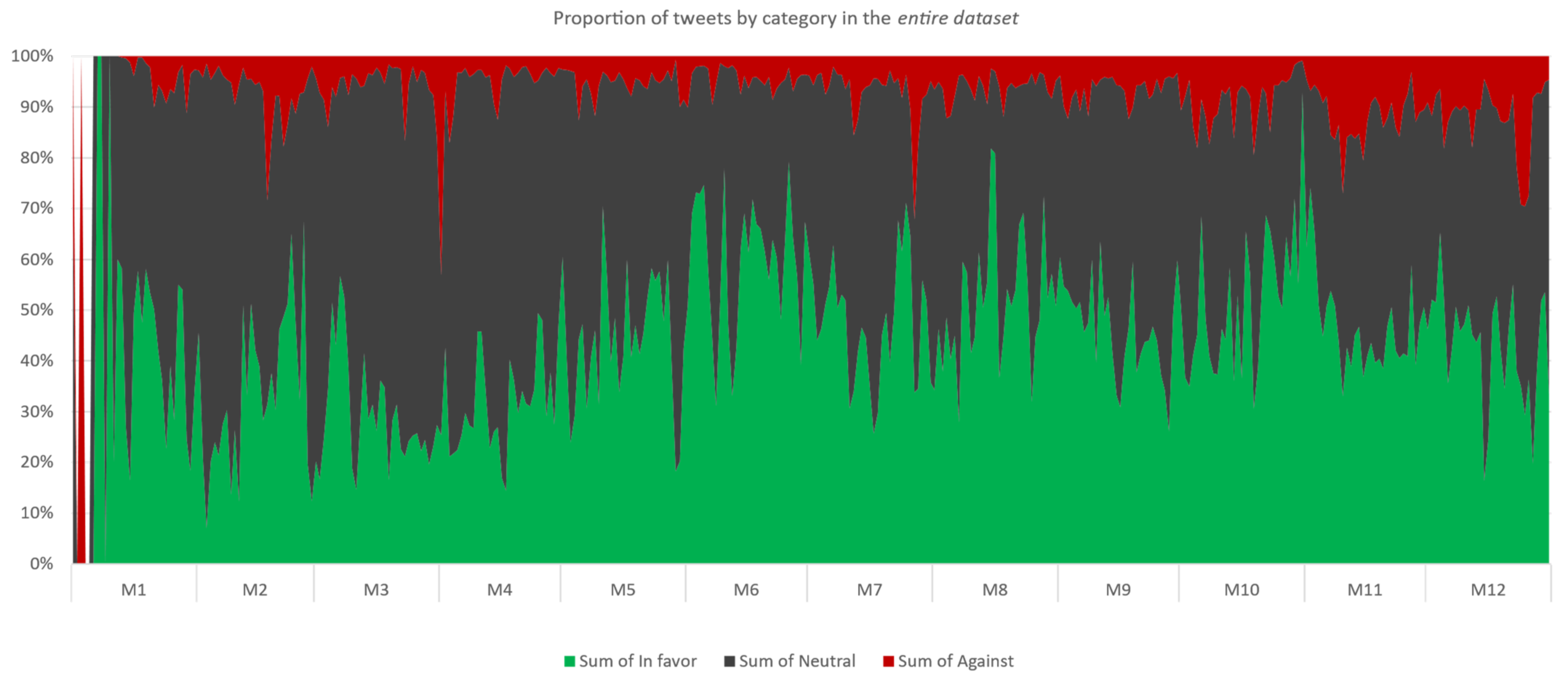
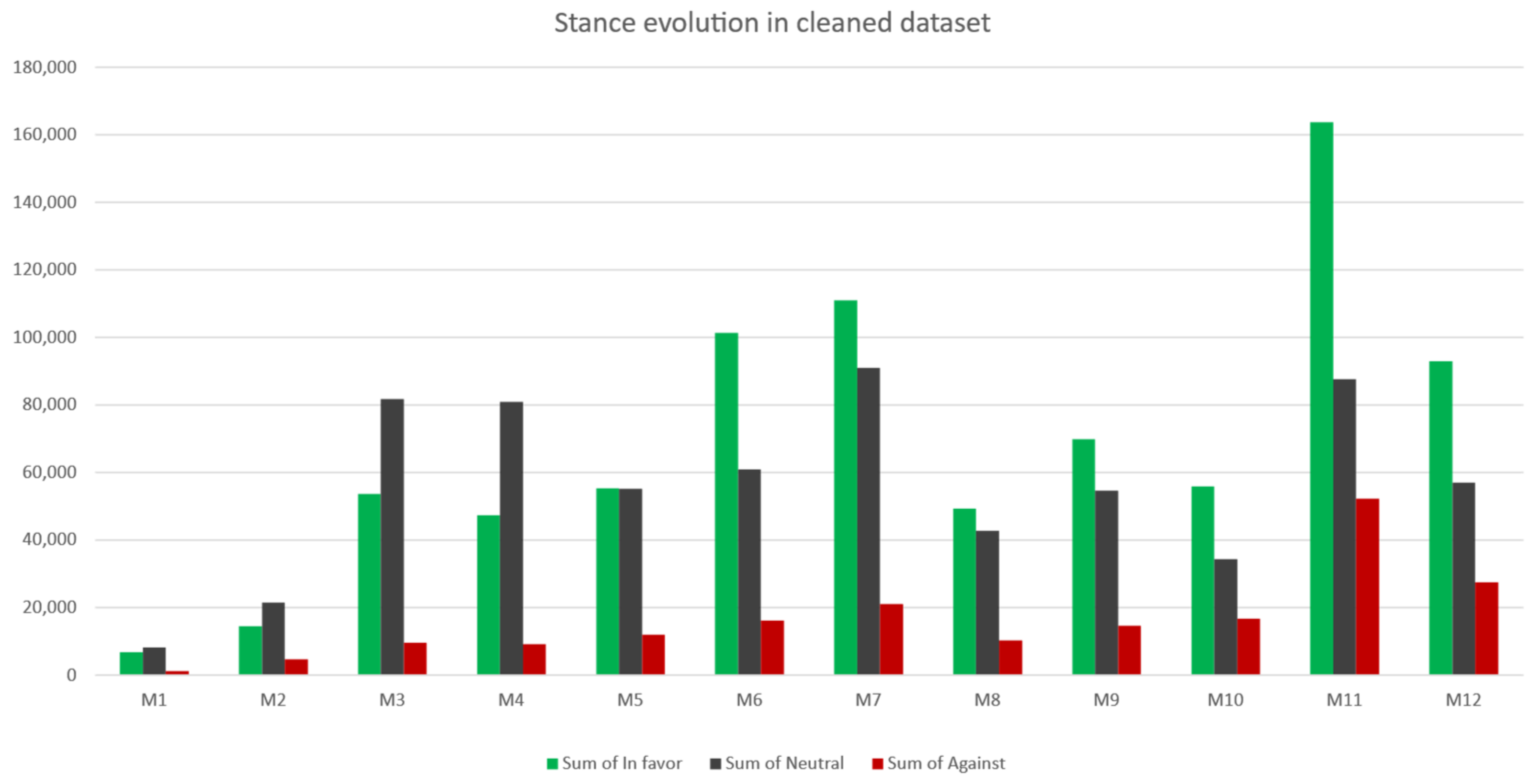
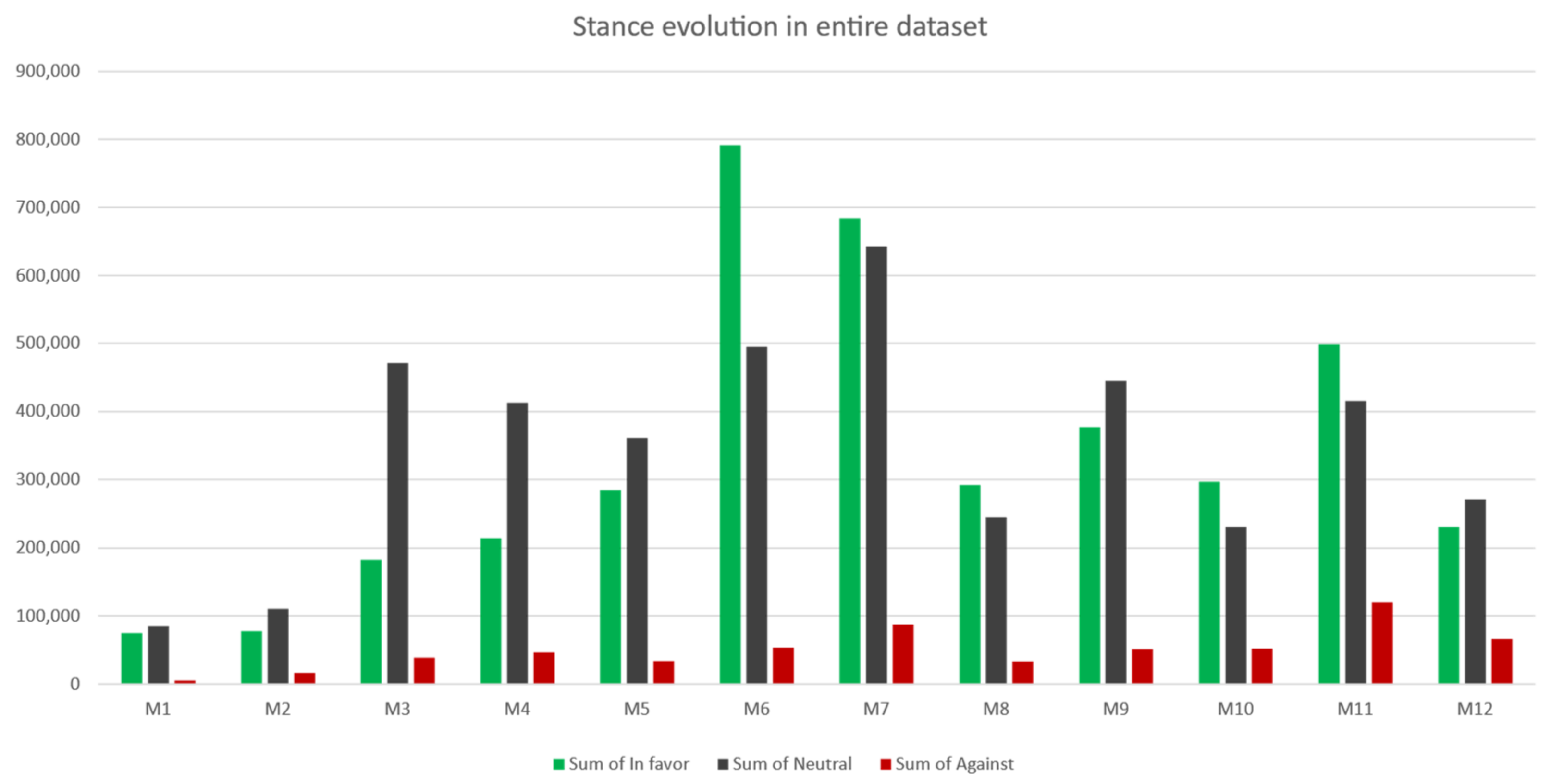
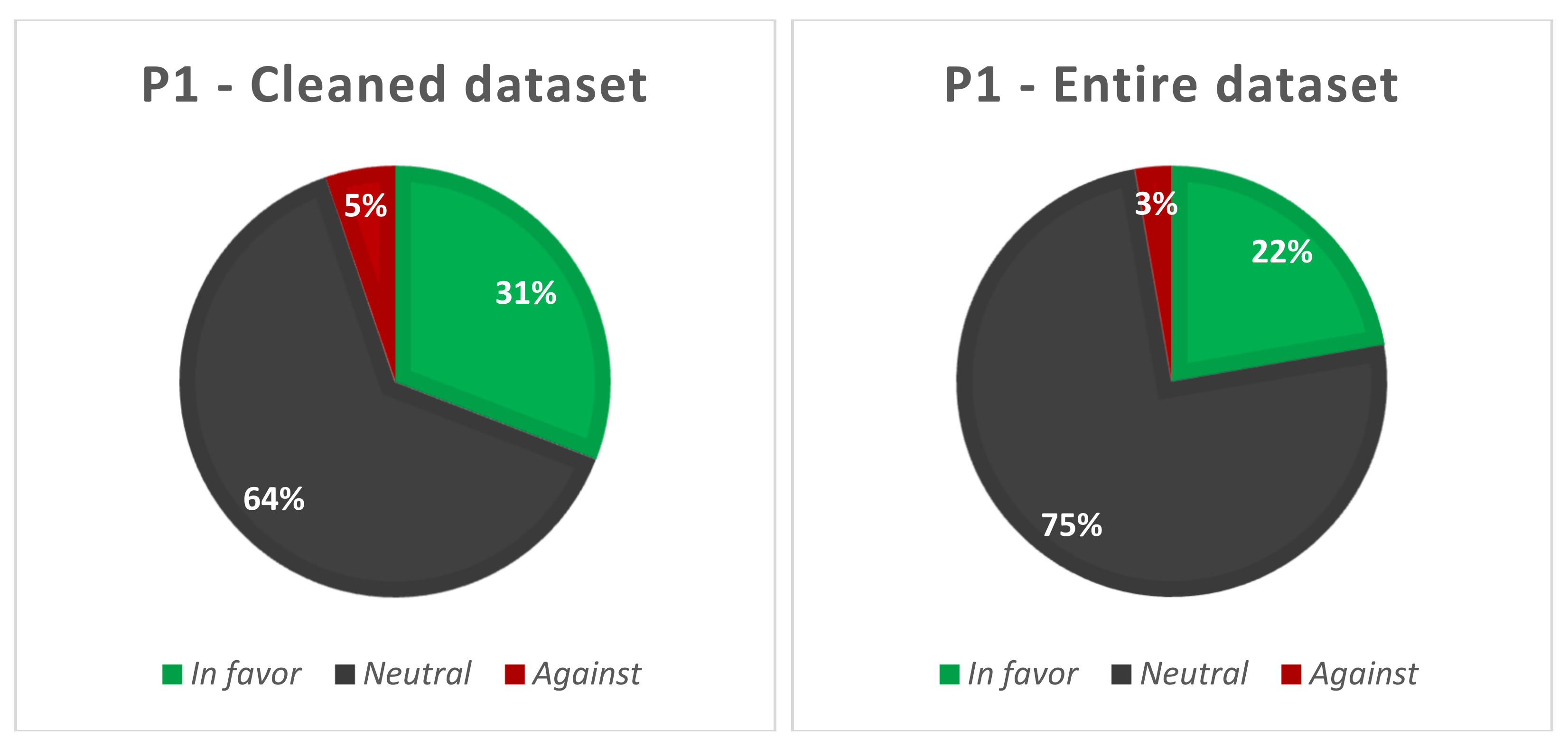
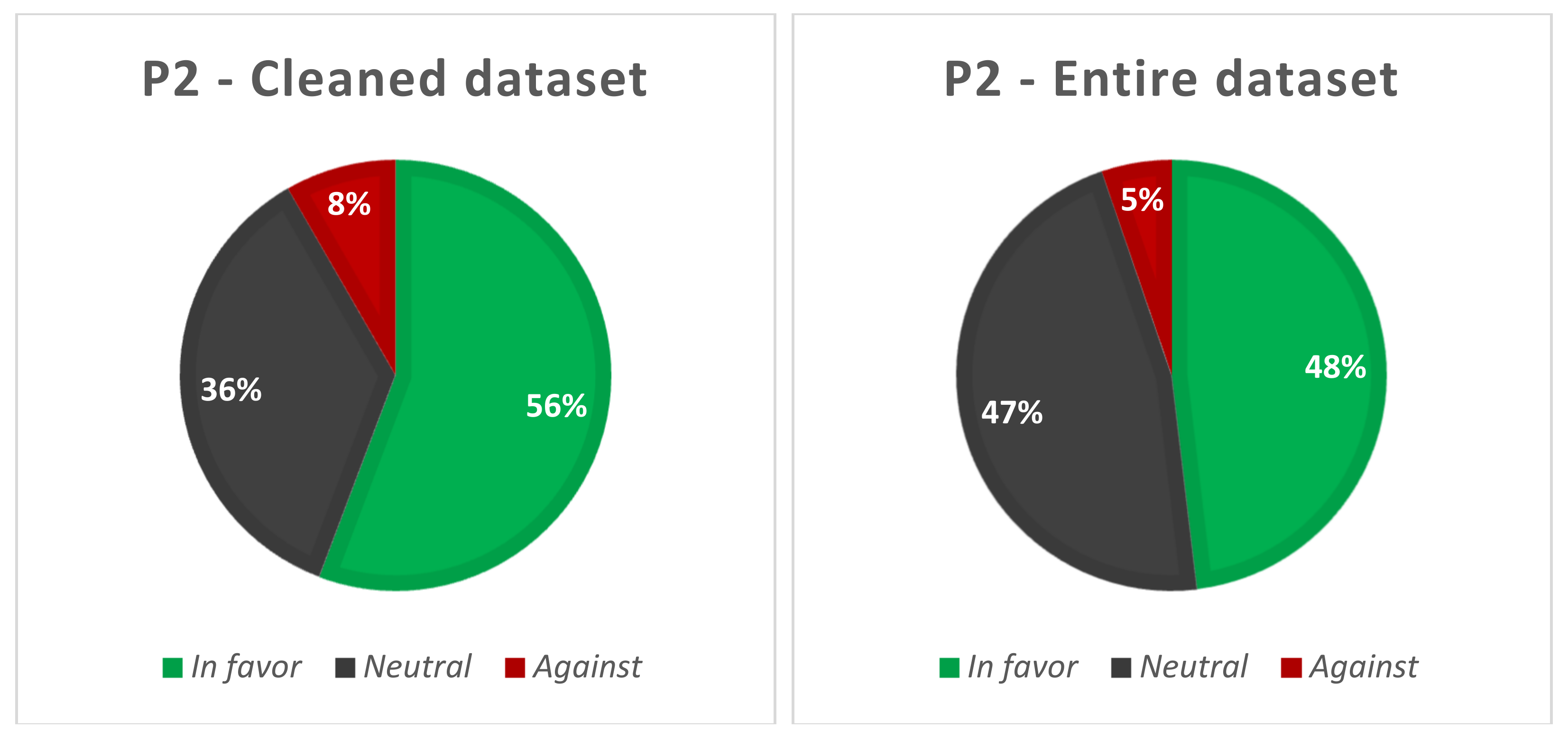
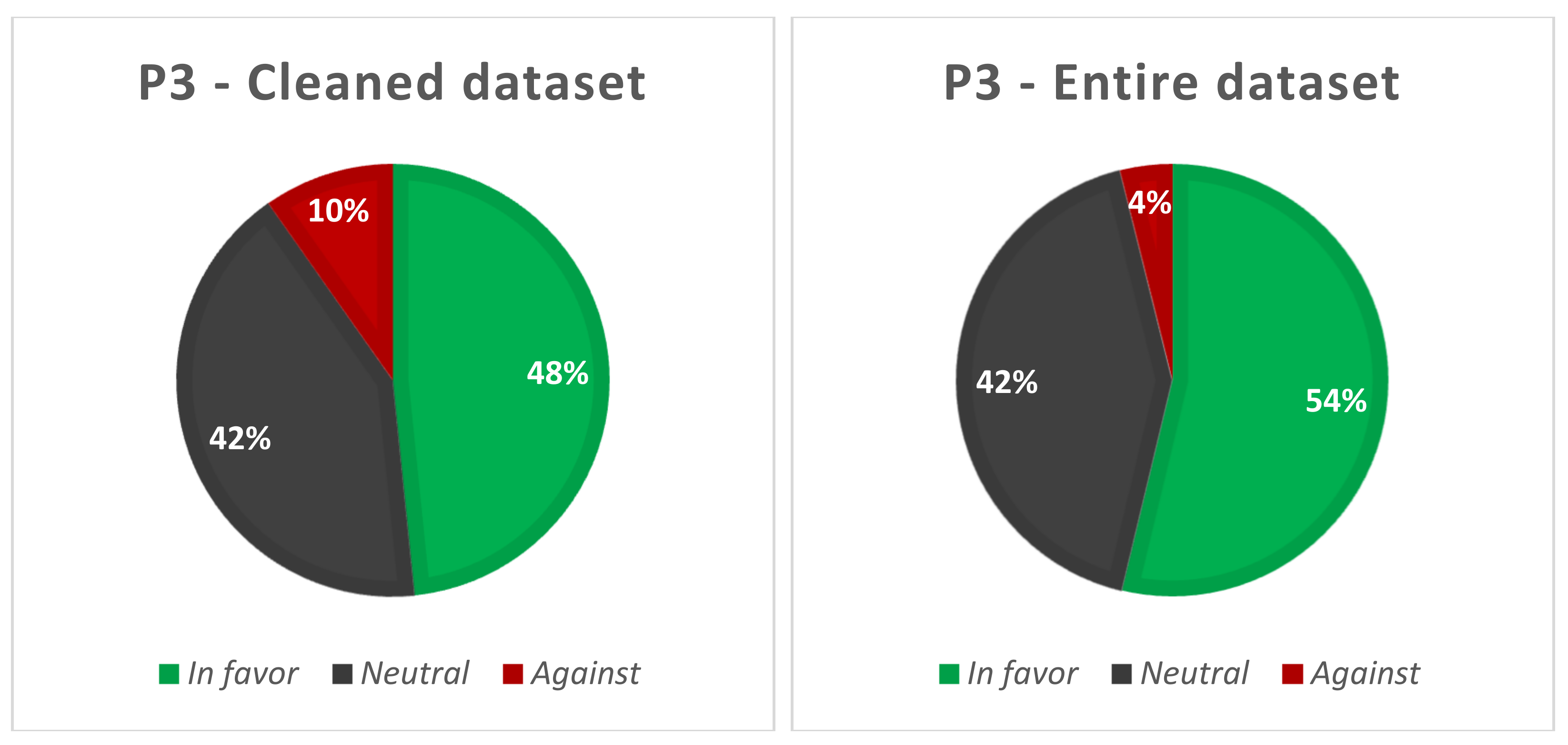
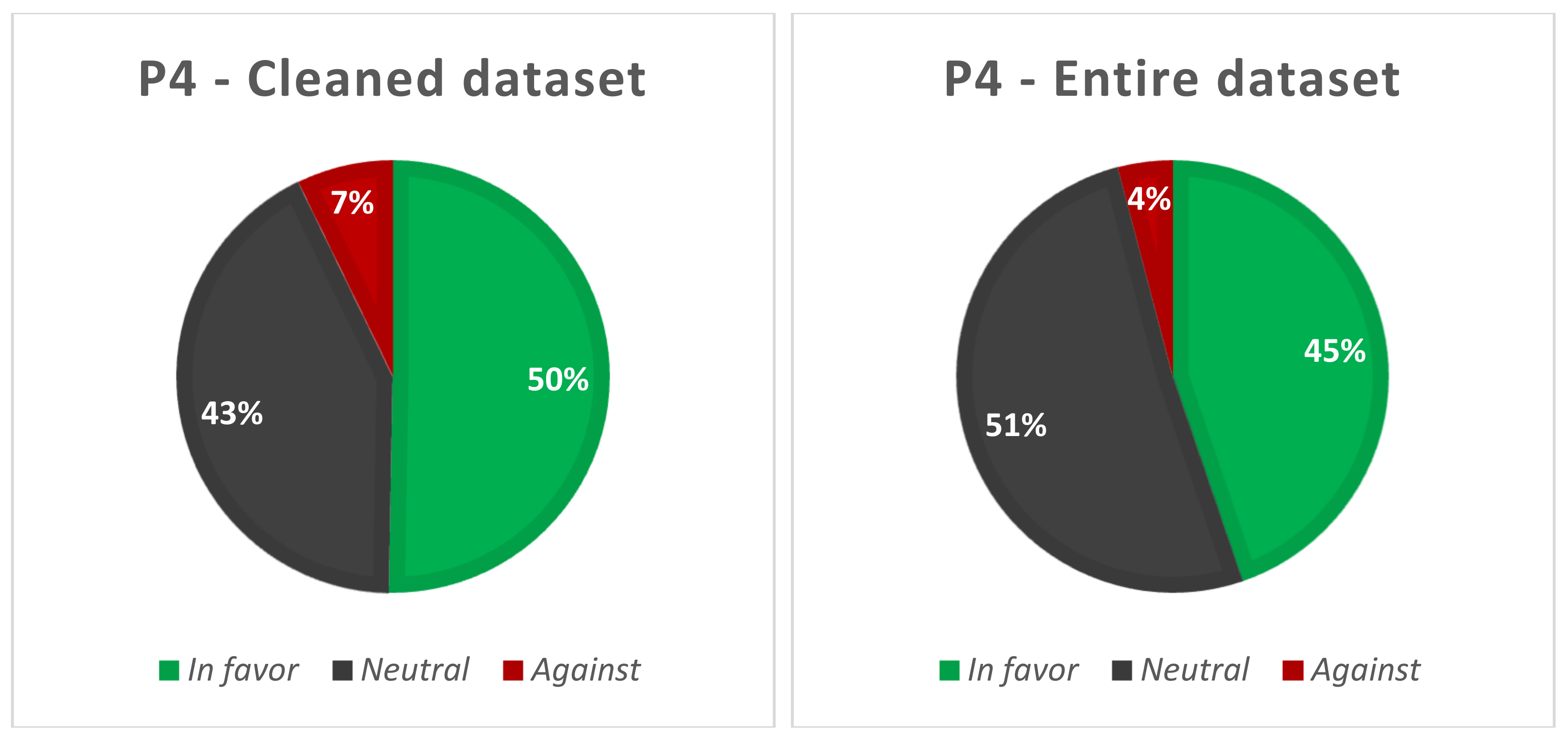
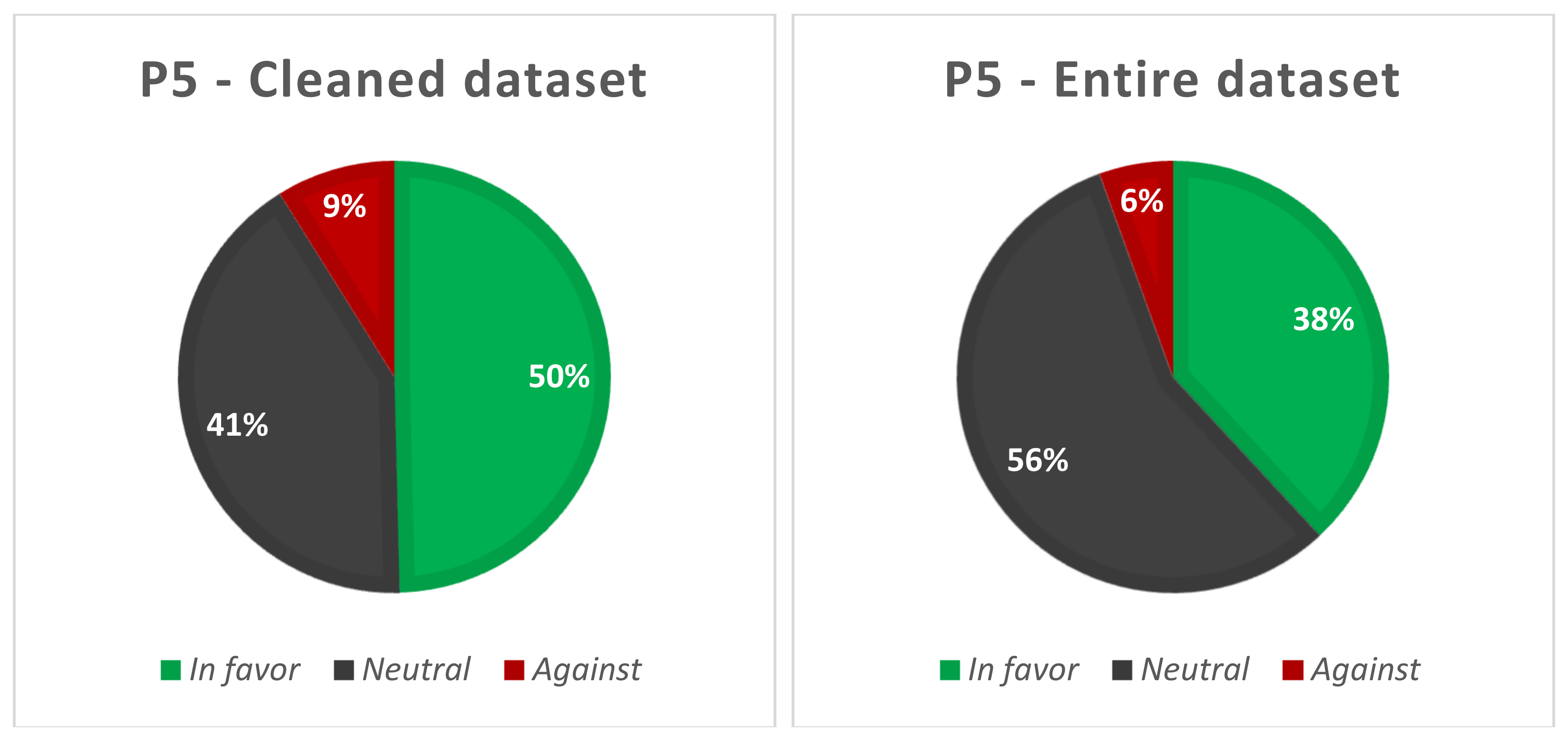
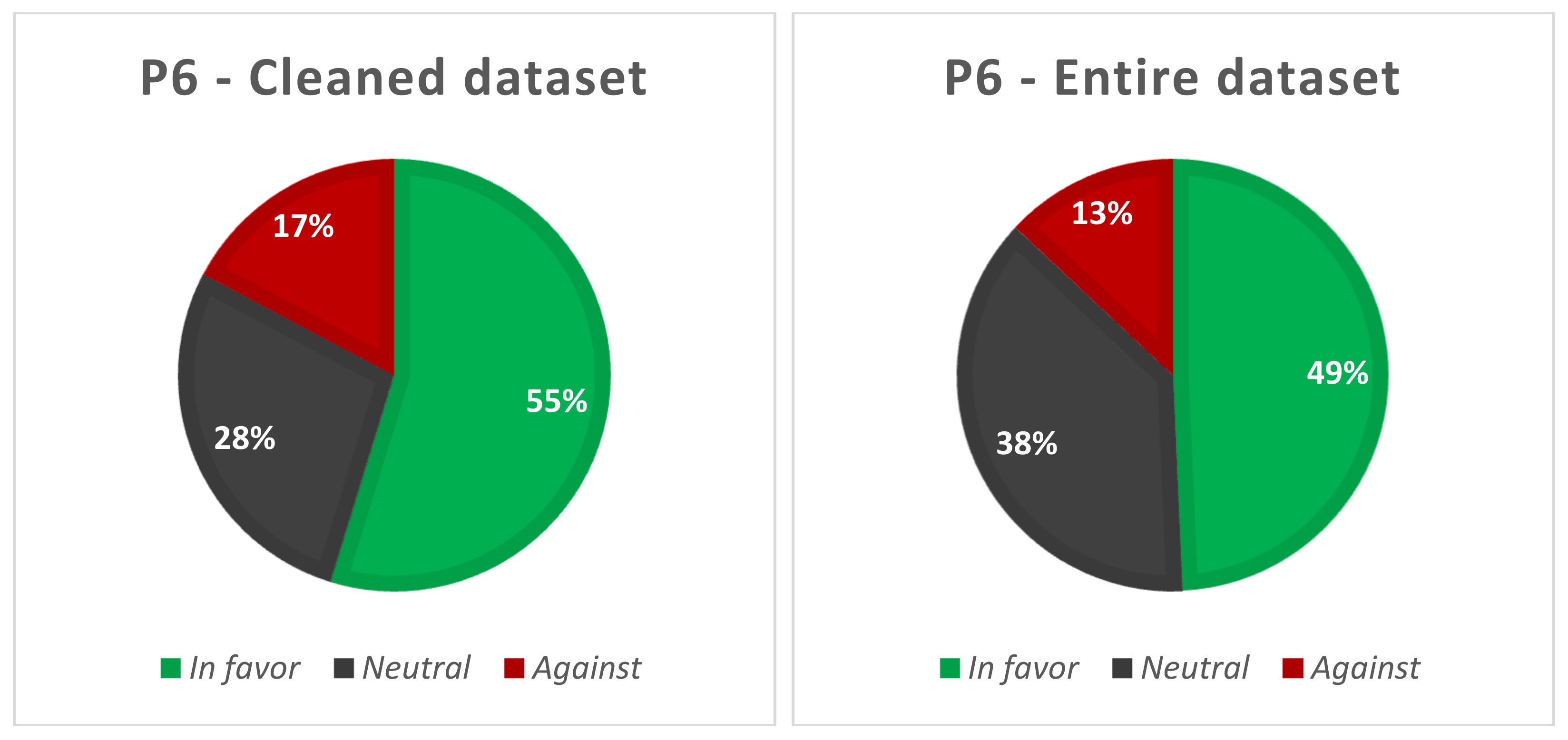
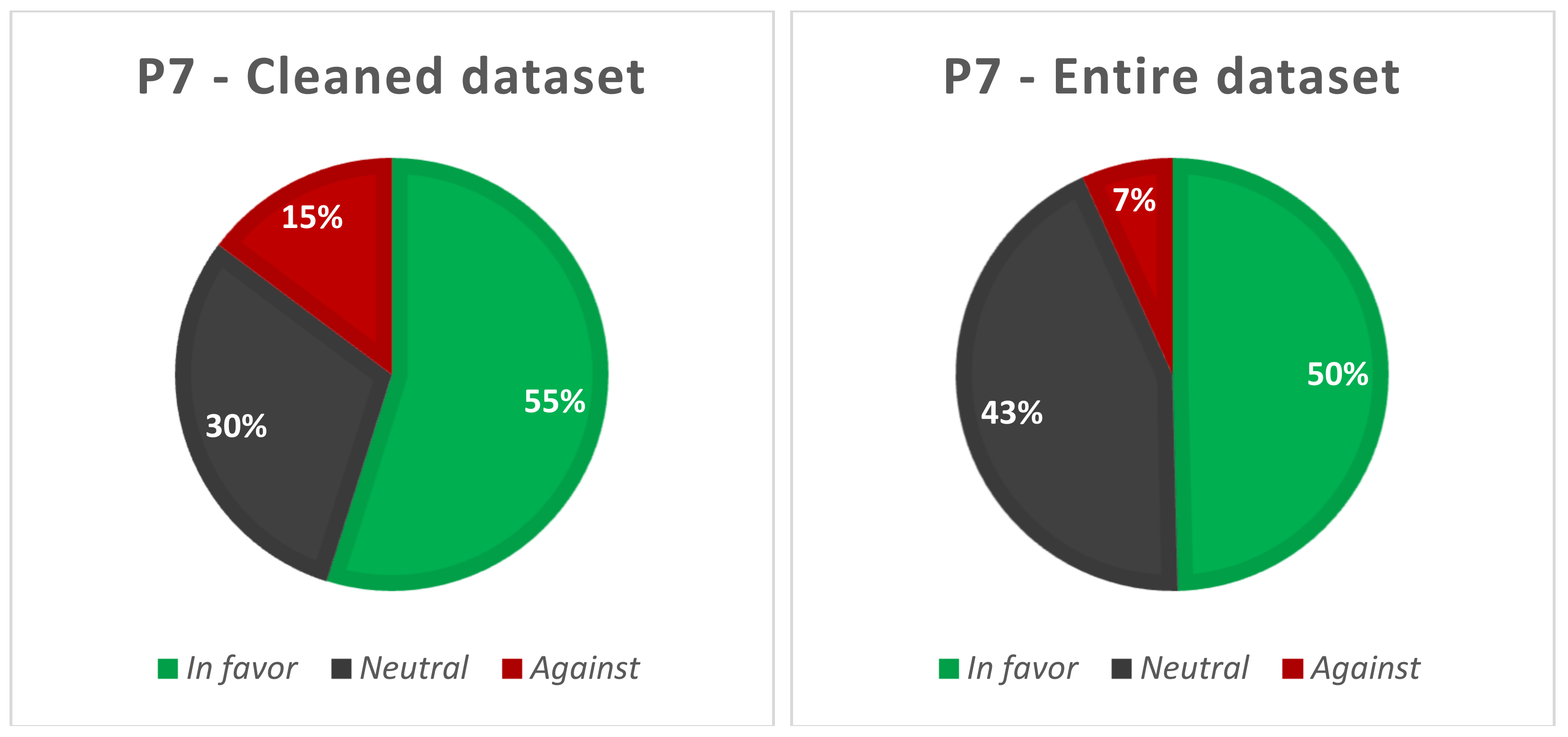
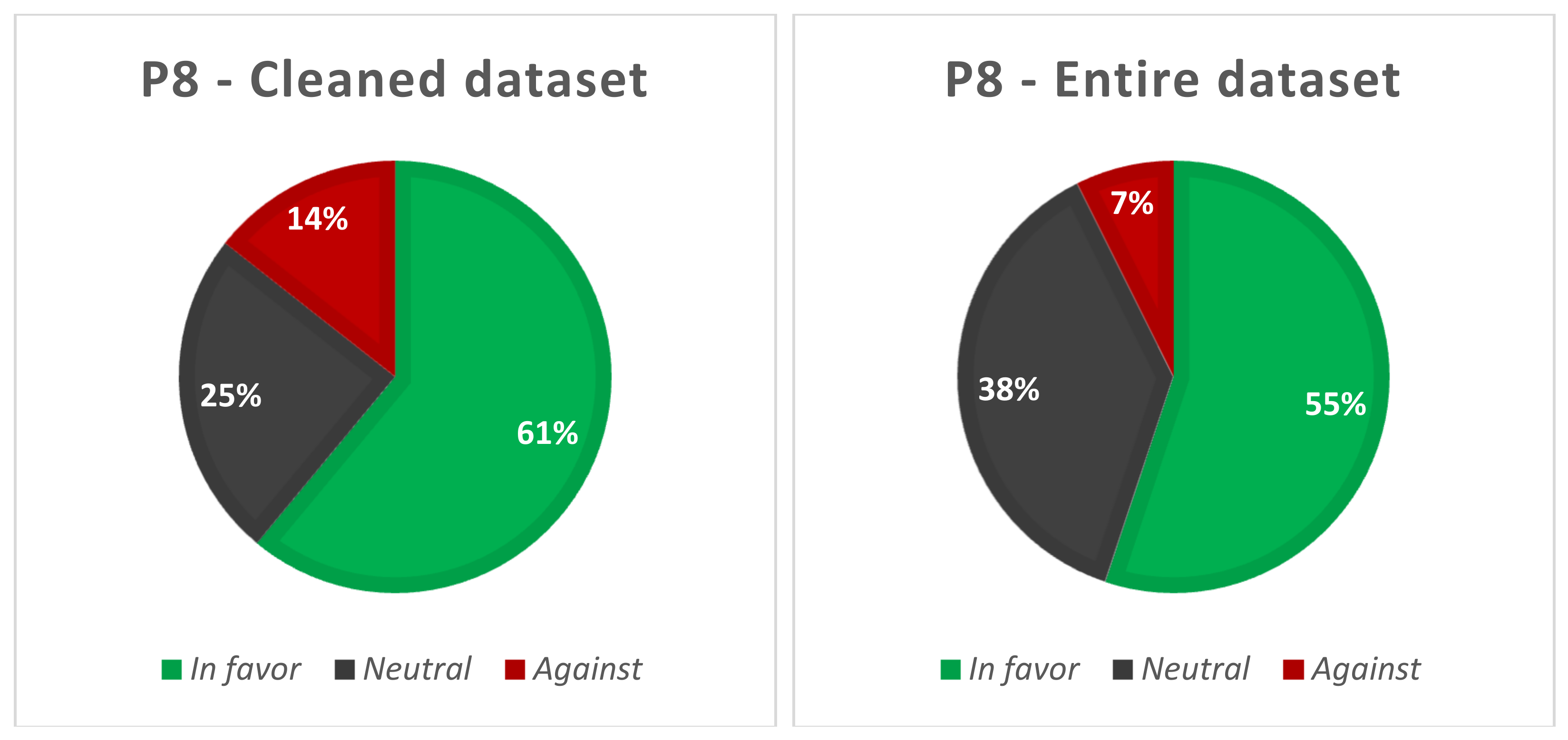
| Topic | Keywords |
|---|---|
| COVID-19 | COVID 19, COVID-19, coronavirus, coronaoutbreak, coronaviruspandemic, wuhanvirus, 2019nCoV |
| Mask | mask |
| Month | M1 | M2 | M3 | M4 |
| Period | 1/9/2020–2/8/2020 | 2/9/2020–3/8/2020 | 3/9/2020–4/8/2020 | 4/9/2020–5/8/2020 |
| Entire dataset | 164,957 | 205,331 | 693,193 | 673,218 |
| Cleaned dataset | 16,248 | 40,666 | 144,947 | 137,425 |
| Month | M5 | M6 | M7 | M8 |
| Period | 5/9/2020–6/8/2020 | 6/9/2020–7/8/2020 | 7/9/2020–8/8/2020 | 8/9/2020–9/8/2020 |
| Entire dataset | 679,352 | 1,340,196 | 1,413,665 | 570,135 |
| Cleaned dataset | 122,558 | 178,477 | 222,916 | 102,224 |
| Month | M9 | M10 | M11 | M12 |
| Period | 9/9/2020–10/8/2020 | 10/9/2020–11/8/2020 | 11/9/2020–12/8/2020 | 12/9/2020–1/8/2021 |
| Entire dataset | 873,153 | 579,978 | 1,034,001 | 568,454 |
| Cleaned dataset | 139,098 | 106,905 | 303,544 | 177,429 |
| Date | Time | Tweet |
|---|---|---|
| 9 January 2020 | 06:34:33 | Stil remember the SARS epidemic in 2003? Experts in China determine the # Wuhan # pneumonia is caused by a new type of coronavirus.Hong Kong health chief didn’t advise citizens to wear mask as a precaution. The govt is seeking to revive the mask ban in-stead. # ChinesePneumonia |
| 07:31:13 | As HK has seen up to 38 citizens infected by the novel corona virus like SARS from Wu-han, the city is running out of mask n saline by both panic purchases n supply ban from China, price soar up to 10 times higher than usual. This also happens in Macau. #SOSHK #ChinesePneumonia | |
| 09:04:37 | Are we still talking about a mask ban now that there’s a new coronavirus outbreak? https://t.co/0R3RKFaPAx |
| Date | Time | Retweet |
|---|---|---|
| 14 January 2020 | 18:44:57 | RT @Atvven: As HK has seen up to 38 citizens infected by the novel corona virus like SARS from Wuhan, the city is running out of mask n saline by both panic purchases n supply ban from China, price soar up to 10 times higher than usual. This also happens in Macau. # SOSHK # ChinesePneumonia |
| 18 January 2020 | 16:10:05 | RT @goldencaskcap: Oh and that scary sounding coronavirus 229E is responsible for what otherwise known as the common cold. It’s been and will be a nasty flu season. Wear a mask, wash hands, and don’t take health advice from political reporters. |
| 21:42:41 | RT @goldencaskcap: Oh and that scary sounding coronavirus 229E is responsible for what otherwise known as the common cold. It’s been and will be a nasty flu season. Wear a mask, wash hands, and don’t take health advice from political reporters. |
| Stance | Tweet |
|---|---|
| in favor | I wear masks all day every day. I don’t feel lightheadedI don’t become hypoxic (low oxygen levels) I don’t become hypercapnic (high CO2 levels) I don’t have symptoms of COVID-19. I wear my mask to protect you. Can you grant me that same courtesy? Thank you in advance  https://t.co/piwXDx5Yfb https://t.co/piwXDx5Yfb |
| Schools begin in August? Really? No mask mandate? Really? #schoolsreopening https://t.co/0Ong4xBAzv | |
| Refusing to Wear a Mask Is Like Driving Drunk https://t.co/ztE9lzUfDH It’s no more a “personal choice” than is drinking all night, then stumbling into your car and heading down the road. In a time of plague, shunning a face mask is like driving drunk, putting everyone in danger. | |
| neutral | Delta passengers who want mask exemption may be required to take pre-flight evaluation https://t.co/btGTHPEUh5 |
| Coronavirus: American Airlines passenger removed for not wearing mask https://t.co/KSMDvAMyED | |
| A security guard who worked at a market in Gardena (Los Angeles County) was charged with murder after he allegedly shot a man who entered the store without a mask, leading to a fight between the pair. https://t.co/5gNRZKVybp | |
| against | Never wear a mask outside in a hot weather! You will get sick that way guaranteed! That’s how they create the 2nd/3rd COVID-19 waive. Don’t be a brainwashed fool! |
@melindagates Wearing a mask for any length of time is detrimental to your health as it reduces your oxygen levels and can affect your immune system. We don’t wear masks for the ‘flu’ and annual vaccines do not prevent us from getting the flu which is a corona virus  | |
| Flu virus = 80–120 nanometers in diameter. COVID-19 = 60–140 nanometers in diameter. Smoke = 2.5–20 nanometers in diameter. Pollen = 90–100 nanometers in diameter. Mask = 300–320 nanometers in diameter. Your mask is an incubator for the very thing your trying to prevent https://t.co/KXZc8xEXf9 |
| Category | Number | Percentage |
|---|---|---|
| in favor | 14,164 | 47.83% |
| neutral | 12,307 | 41.56% |
| against | 3142 | 10.61% |
| TOTAL | 9426 | 100.00% |
| N-Grams | Description |
|---|---|
| (1-1) | unigrams |
| (2-2) | bigrams |
| (3-3) | trigrams |
| (1-2) | unigrams and bigrams |
| (2-3) | bigrams and trigrams |
| (1-3) | unigrams, bigrams and trigrams |
| Code | Classifier | Class | Precision | Recall | F-Score | Accuracy |
|---|---|---|---|---|---|---|
| C1 | MNB n-gram: (1, 3); features: all | in favor | 68.17% | 76.13% | 71.89 | 75.44% |
| neutral | 91.43% | 67.28% | 77.48 | |||
| against | 72.39% | 82.91% | 77.28 | |||
| C2 | MNB n-gram: (1, 2); features: all | in favor | 66.10% | 78.52% | 71.74 | 75.12% |
| neutral | 91.45% | 66.30% | 76.83 | |||
| against | 74.24% | 80.55% | 77.25 | |||
| C3 | RF n-gram: (1, 3); features: all | in favor | 69.47% | 70.72% | 70.05 | 74.85% |
| neutral | 75.55% | 83.48% | 79.29 | |||
| against | 80.42% | 70.37% | 75.04 | |||
| C4 | RF n-gram: (1, 2); features: all | in favor | 68.91% | 72.47% | 70.61 | 75.16% |
| neutral | 78.19% | 81.76% | 79.89 | |||
| against | 79.18% | 71.26% | 74.99 | |||
| C5 | SVM n-gram: (1, 3); features: all | in favor | 76.03% | 72.66% | 74.25 | 78.63% |
| neutral | 87.19% | 77.47% | 82.00 | |||
| against | 74.42% | 85.77% | 79.66 | |||
| C6 | SVM n-gram: (1, 2); features: all | in favor | 75.11% | 73.52% | 74.28 | 78.79% |
| neutral | 85.50% | 79.70% | 82.47 | |||
| against | 76.52% | 83.16% | 79.67 | |||
| C7 | BERT cased: yes | in favor | 77.16% | 79.78% | 78.39 | 82.38% |
| neutral | 87.44% | 83.13% | 85.19 | |||
| against | 83.11% | 84.23% | 83.59 | |||
| C8 | BERT cased: no | in favor | 75.50% | 81.66% | 78.45 | 82.60% |
| neutral | 89.32% | 82.70% | 85.85 | |||
| against | 84.12% | 83.37% | 83.72 | |||
| C9 | RoBERTa | in favor | 81.76% | 83.20% | 82.39 | 85.38% |
| neutral | 89.73% | 84.21% | 86.82 | |||
| against | 85.32% | 88.71% | 86.92 |
Publisher’s Note: MDPI stays neutral with regard to jurisdictional claims in published maps and institutional affiliations. |
© 2021 by the authors. Licensee MDPI, Basel, Switzerland. This article is an open access article distributed under the terms and conditions of the Creative Commons Attribution (CC BY) license (https://creativecommons.org/licenses/by/4.0/).
Share and Cite
Cotfas, L.-A.; Delcea, C.; Gherai, R.; Roxin, I. Unmasking People’s Opinions behind Mask-Wearing during COVID-19 Pandemic—A Twitter Stance Analysis. Symmetry 2021, 13, 1995. https://doi.org/10.3390/sym13111995
Cotfas L-A, Delcea C, Gherai R, Roxin I. Unmasking People’s Opinions behind Mask-Wearing during COVID-19 Pandemic—A Twitter Stance Analysis. Symmetry. 2021; 13(11):1995. https://doi.org/10.3390/sym13111995
Chicago/Turabian StyleCotfas, Liviu-Adrian, Camelia Delcea, Rareș Gherai, and Ioan Roxin. 2021. "Unmasking People’s Opinions behind Mask-Wearing during COVID-19 Pandemic—A Twitter Stance Analysis" Symmetry 13, no. 11: 1995. https://doi.org/10.3390/sym13111995
APA StyleCotfas, L.-A., Delcea, C., Gherai, R., & Roxin, I. (2021). Unmasking People’s Opinions behind Mask-Wearing during COVID-19 Pandemic—A Twitter Stance Analysis. Symmetry, 13(11), 1995. https://doi.org/10.3390/sym13111995








